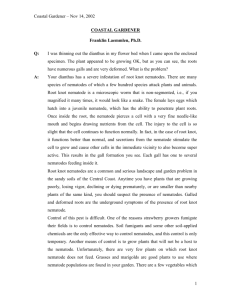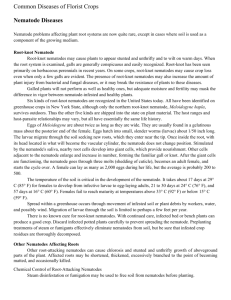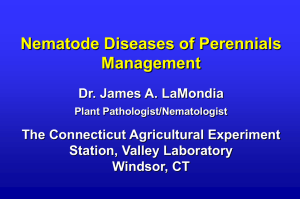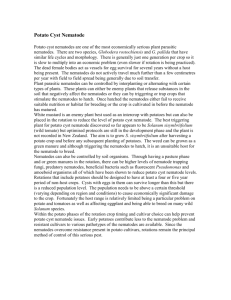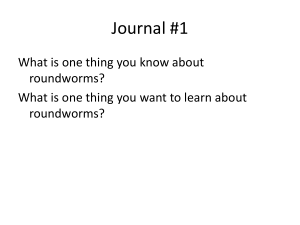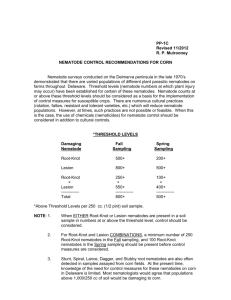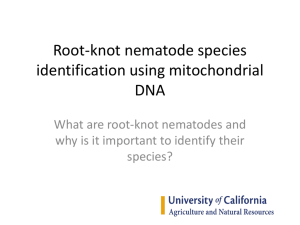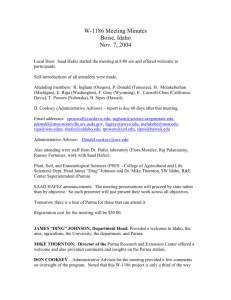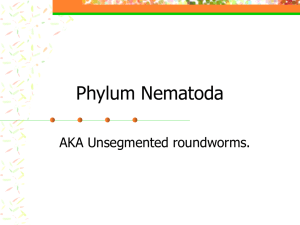Signs and Symptoms of Damage on Perennials Slides
advertisement
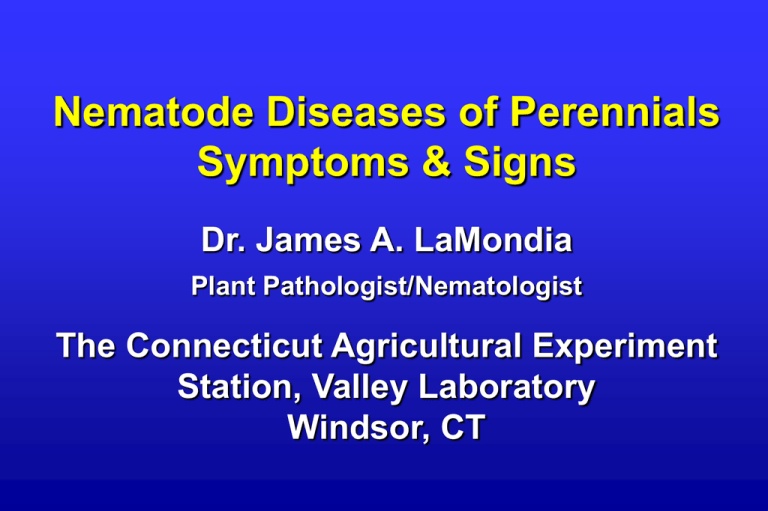
Nematode Diseases of Perennials Symptoms & Signs Dr. James A. LaMondia Plant Pathologist/Nematologist The Connecticut Agricultural Experiment Station, Valley Laboratory Windsor, CT Nematodes Infecting Perennials Meloidogyne hapla - root-knot Aphelenchoides - foliar nematodes Ditylenchus - stem/bulb nematodes Pratylenchus - lesion nematodes Nematode Diagnostics 30% (99 of 333) samples submitted over 5 years were infected with Meloidogyne hapla Perennial Ornamentals > 2500 species in >500 genera. Value over $1 billion in US. Propagation by division, seed, and cuttings. Non-specific Damage Symptoms of poor roots Poor color and vigor Reduce winter hardiness Secondary pathogens/diseases Nematodes Infecting Perennials Meloidogyne hapla - root-knot Aphelenchoides - foliar nematodes Ditylenchus - stem/bulb nematodes Pratylenchus - lesion nematodes Nematodes Infecting Perennials Meloidogyne hapla - root-knot Aphelenchoides - foliar nematodes Ditylenchus - stem/bulb nematodes Pratylenchus - lesion nematodes Nematode Diseases of Tree Fruits Nematode Damage Reduce tree vigor and yield Reduce winter hardiness Transmit viruses (TmRSV) - apple union necrosis - peach stem pitting Replant Diseases Nematodes Infecting Tree Fruits Pratylenchus - lesion nematodes Xiphinema - dagger nematodes Criconemella - ring nematodes Meloidogyne hapla - root-knot Nematode Damage Levels 3 cm Lesion - 25-150 per 100 soil Ring - 50-200 per 100 cm3 soil 3 Dagger - 1-100 per 100 cm soil (depends on TmRSV) Apple Replant Trees appear stunted, and growth uneven and slow. Associated with lesion nematodes, soil fungi and bacteria, and poor soil conditions. Apple or Fruit Replant Disease Ring Nematode Apple Union Necrosis Apple Union Necrosis Problem only on size-controlling rootstocks such as MM106 and scions such as Red Delicious. Shoot growth reduced, heavy set of small fruit, not always lethal. Tomato RingSpot Virus History Weed Hosts of TmRSV Common chickweed Lambsquarters White-head aster Oxeye daisy Common thistle Dandelion Wild carrot Swine or Pennycress Leafy/prostrate spurge Red or White clover Common polkweed Buckhorn plantain Common mullein Common plantain Sheep sorrel (red) Curly dock Wild strawberry Broadleaf plantain Peach Stem Pitting Affected trees appear girdled, lose vigor and eventually die. Trees often yellow early, and set a large number of small fruit. Pits or grooves occur in rootstock. Cultural Practices • Site preparation • Rotation crops - Brassicas or sorghosudan/sudangrass. • Sod strips - perennial rye or fescue grasses and weed control. Nematicides • Need determined for each field • Fumigant Nematicides 1,3-dichloropropene metam sodium or dazomet • Non-fumigant Nematicides Fenamiphos or oxamyl Strawberry Black Root Rot: Plant and Pathogen Interactions James A. LaMondia The Connecticut Agricultural Experiment Station Valley Laboratory Windsor, CT DISEASE TRIANGLE DISEASE Environment Effect of pathogens on root disease and length %BRR Structural Feeder None 10 526 1124 Rf alone 22 491 1440 Rf + Pp 46 411 654 Strawberry Root Types Structural roots – 1° & 2 ° developed cortex. Perennial roots – 2 ° tissues root cortex sloughed off. Feeder roots – 1 ° tissues short-lived, quick cycles. well Pratylenchus recovery per g root Root type 1997 1998 Perennial 1.2 23.5 Structural 27.8 118.1 136.6 335.0 1.2 8.4 Feeder Soil R. fragariae isolation %2mm roots Root type Spring Harvest Perennial 52 78 Structural 3 40 Feeder 12 27 Pp lesion 17 73 Nematode-Fungus Interactions Split Root Experiments pot 1 pot 2 Pp None None None Rf Pp+Rf Pp Rf Nematode-Fungus Split Root pot 1 pot 2 %BRR Pp Rf 14 b None Pp+Rf 26 a None Pp 12 b None Rf 8 b Nematode-Fungus Interactions Rf and Pp associated with BRR. Additive pathogen interaction. Split root – local interaction. Pp no effect on root exudates or Rf growth in amended media. Nematode-Fungus Interactions Rf resident on strawberry roots. Secondary growth > Rf infection. Nematode lesions > Rf infection. Pp, 2° growth cause cell death. Rf infects dead cells healthy. Strawberry health Root growth vs. root loss Tolerance to BRR Insect interactions, white grubs and weevils - breeding Management Research Nonhost / antagonistic crops. Effect of fertilizer/pH on BRR. Fungicides - Root drench/dip trt Biological control: PGPR; cvs. IPM – nematode bioassay


